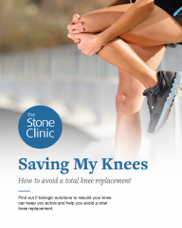ACL Surgery: What’s New for 2023
ACL Surgery has advanced too slowly. The failure rates are still high and the choices of grafts are confusing. Here is what I think you should do if you tear your ACL.

You twist your knee, hear a pop, and your knee swells. This is a common ACL injury story. You may describe your injury to your doctor by putting your fists one on top of the other and sliding them back and forth. This is called the “two-fisted sign,” and almost everyone who has an unstable knee from an ACL injury knows that feeling.
The first step is to get an accurate diagnosis. The history, physical exam, x-ray, and MRI all provide a portion of the key data needed to assess the type of ACL tear and the necessary course of action. Be sure to get all these diagnostic procedures. Don’t skimp on low-field low-quality imaging and don’t wait. Early repair for some ACL injuries is critical.
The next step is deciding who will treat you and what treatment to follow. The “who” depends on who you trust, how soon you can see them, and how smart, creative, talented, experienced, and thoughtful they are—about you, your injury, and your goals. To reduce your chances of treatment failure, the doctor you pick matters. Your course of action will involve a choice between non-operative treatment, primary repair, and complete replacement (i.e. reconstruction). Here is the thinking on all of these options as of today.
Non-operative treatment works for a surprising number of people. This means the knee heals well enough to permit a return to full sports without symptoms. These individuals often have ACL-independent knees (knees that don’t rely for stability as much on their ACL), true partial tears (which tend to heal well enough on their own), and show no associated damage in their meniscus cartilage, articular cartilage, or peripheral ligament. We add growth factor injections with hyaluronic acid (HA) to their joint to augment healing. A great rehab program is the only thing these patients seem to need.
Primary repair of the torn ACL works best in partial tears. In these cases, the surgeon places sutures and sometimes collagen scaffolds or augmentation devices to line up the collagen fibers, giving the ligament a chance to heal. Unfortunately, the amount of force necessary to tear the ligament even partially often damages the fibers throughout the ACL. This is the probable cause for many ACL repair failures and the reason why most surgeons avoid primary repairs. But 2022 saw a new enthusiasm for augmenting ACL repairs and the results may improve the outcomes for a select number of partial ACL tears.
Replacement (reconstruction) of the ACL has been plagued by a higher failure rate than is openly acknowledged. The knees from which the surgeon takes the patellar tendon, or the hamstring tendons, have a failure rate of up to 30% in young people and a 50% chance of developing arthritis by 10 years. Donor tissues from allograft banks have a mixed success rate, depending on the quality of the tissue and multiple other factors.
In 2022, there has been a shift in thinking with surgeons trying to deploy thicker tissue from the quadriceps tendon in the thigh (taken from the injured patient or the tissue bank). These grafts are being augmented with growth factors from PRP, either at the time of surgery or in the early post-op period, to reduce inflammation and scarring and possibly even the onset of arthritis. The widespread belief that donor tissues can’t be used successfully in young people is not supported by our own experience of using thicker tissues, augmented by growth factors. We hold the belief that harvesting young people’s own tissues is not the best thing to do.
Another critical shift has been the re-introduction of lateral extra-articular reconstruction with any ACL surgery. Two key factors have been documented. (1) ACL injuries are often accompanied by injuries to the lateral side of the joint, which are frequently missed; and (2) by adding a graft to the side of the knee the ACL is protected during the healing period, diminishing the stretching out that a new graft may endure. Here is where an experienced knee examiner can determine the degree of rotational laxity that an MRI cannot. We now often add this extra graft to our ACL surgical procedures. We have designed a lateral technique that does not involve the lateral collateral ligament, yet still provides superb support for the reconstructed ACL.
Another improvement has been the recognition that many ACL injuries also have meniscus injuries. It is critical to repair, rather than resect or ignore, these associated injuries. The meniscus does more than provide stress protection; it is also a key stabilizer of the knee. A torn meniscus allows the knee to slide back and forth, accelerating the arthritis and the ACL stress. We push the limits to repair a vast number of meniscus tears that previously were thought to be irreparable.
Our preferences? Quad tendon donor tissue, extra-articular augmentation, precise anatomic placement, and meniscus and articular cartilage repair in knees that are unstable. Non-operative care for those knees that meet the criteria of low demand or minimal instability on testing. Primary surgical repair for the select few ligaments that appear to be partially torn and perfect on MRI and testing for a suture-only repair.
All surgery is improved by unflagging rehabilitation and fitness exercises. These should be started on Day One after the injury and continued daily. We also recommend the use of anabolic injection factors (today PRP, tomorrow birth tissues and exosomes), which recruit the body’s stem-cell-derived progenitor cells to augment healing.
With these notes of progress, 2023 is looking better for the unlucky ones whose ACL fails them. As physicians, scientists, and surgeons, we intend to keep the progress going. Still, an ounce of protection, with pre-season exercises and mindful sports participation, is worth a pound of surgical expertise.


